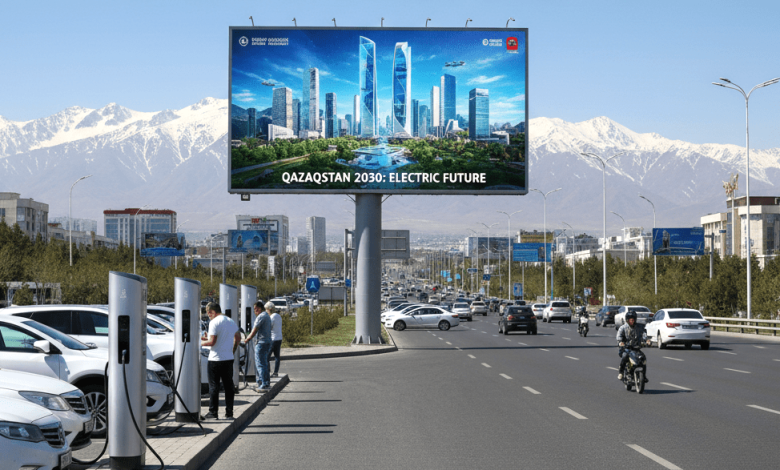Electric Vehicles in Kazakhstan: Growth, Gaps, and the Road Ahead

Despite growing interest in environmentally friendly transport, the share of electric vehicles (EVs) in Kazakhstan remains modest. This is due to their relatively late entry into the domestic market, persistent public skepticism, and an underdeveloped charging infrastructure. Nevertheless, electric mobility is already seen as a crucial component of Kazakhstan’s future transport strategy and its broader sustainable development agenda.
These are among the conclusions of a new study analyzing the state of the EV fleet in Kazakhstan and proposing measures to develop urban electric transport infrastructure.
According to official registration data, more than 19,000 electric cars and motorcycles were registered in Kazakhstan in the first half of 2025, a figure that reflects steadily rising interest in EV adoption.
More EVs, Fewer Charging Stations
If current trends continue, the EV fleet in Kazakhstan could increase more than tenfold by 2030, says Seydulla Abdullaev, Doctor of Technical Sciences and Head of the School of Transport Engineering and Logistics at the Satbayev Kazakh National Research Technical University. However, the pace of charging infrastructure development continues to lag.
“Even with the current ratio of 25 electric vehicles per charging station, Kazakhstan will need between 4,000 and 8,000 charging points by 2030. This will require significant investment, an updated regulatory framework, and more active participation from the private sector,” Abdullaev told The Times of Central Asia.
By comparison, in China, the global leader in EV production and charging infrastructure, one station serves an average of ten electric vehicles, a level considered high by industry standards. In Europe, EV charging stations are installed along highways at intervals of roughly 50 km. In contrast, only 23 such stations are currently operational on Kazakh highways.
International best practices highlight the value of equipping residential complexes and parking lots with courtyard chargers, especially when backed by state subsidies.
In Kazakhstan, a roadmap adopted in 2023 mandates that necessary EV infrastructure be established in all major cities by 2029. However, progress has been slow. In Almaty, which accounts for approximately 60% of the nation’s EV fleet, only 23 of the 40 planned charging stations were completed by 2024.
“Our analysis shows that the key barriers to electric transport development include inadequate infrastructure, a limited service base, and underdeveloped technical documentation. Moving forward, progress will largely depend on political decisions, particularly in areas such as EV production subsidies, charging station expansion, and buyer incentives,” Abdullaev noted.
Incentive Cuts Threaten Market Growth
Kazakhstan’s EV market has increasingly aligned with global trends, particularly the dominance of Chinese manufacturers. Today, around 70% of EVs in the country are made in China, followed by about 20% from the U.S., and the rest from Germany, Belgium, Austria, and Japan. According to Natalya Tokmurzina-Kobernyak, Associate Professor at the School of Transport Engineering and Logistics at Satbayev KazNITU, this technological diversity demands a broad and well-supported service infrastructure.
The global EV fleet, which stood at 58 million in 2020, had nearly quintupled by the end of 2024, according to the International Energy Agency. That figure is expected to reach 400 million by 2030. Two-thirds of these vehicles are battery electric, with hybrids making up the remainder.
In Kazakhstan, however, legislation only classifies battery electric vehicles as EVs. Hybrids are excluded under the Law “On Road Traffic.”
Researchers warn that the cancellation of import privileges could hurt EV adoption. The current exemption from customs duties was limited to 15,000 vehicles, a quota that has already been filled. Starting January 1, 2026, individual buyers will be required to pay 16% VAT, although the zero rate for transport and disposal taxes will remain. This is expected to raise EV prices by 30-40%.
EV charging network operators, who had anticipated a growth in demand, are now tempering their expectations. Bulat Pultambekov, a representative of the EVS charging station network, says the company is revising its business forecasts amid concerns about longer payback periods and tighter financing conditions.
Globally, governments offer extensive EV incentives. In the UK, subsidies reach $7,800; in France, up to 30% of a car’s value. Other common incentives include tax exemptions, free parking, use of public transport lanes, toll-free road access, zero VAT, and customs duty waivers.
The study modeled three development scenarios for EV mobility in Kazakhstan through 2030. Under the optimistic scenario, with continued state support, the EV fleet could grow to 120,000 units. A realistic projection puts the number at 78,000 (approximately 12% of the national vehicle fleet), while an inertial scenario, assuming limited policy support, projects growth to just 42,000 units.
“With the removal of import subsidies in 2025, we expect slower growth, even if the overall upward trend continues. As a result, the EV share will remain at 12-16%,” the study notes.
Who is Responsible for the Transition?
Kazakhstan has already adopted a basic legislative framework for EV regulation, including 17 national and 8 interstate standards for vehicles and chargers. Separate documents outline energy usage rules, and electrical safety is addressed in fire and installation regulations.
Yet, according to Tokmurzina-Kobernyak, the regulatory environment remains fragmented.
“We don’t have a dedicated law ‘On Electric Vehicle Transport’ that would consolidate all the disparate regulations,” she said, adding that Kazakhstan also lacks a single state body responsible for coordinating EV policy.
To fill these gaps, she recommends passing a specialized EV law, amending the Urban Planning Code, and introducing unified technical standards for charging station installation, adjusted for climatic differences across regions.
“Without systemic action, we cannot achieve zero harmful emissions,” she stressed.
One unresolved challenge is battery disposal. With an average lifespan of 5-7 years, the growing number of batteries will soon become an environmental concern. Safety is another issue: lithium-ion batteries can suffer from thermal runaway, leading to fire or explosion.
Though the technology is still emerging, several countries are already testing rapid heat-suppression systems. Kazakhstan’s fire services are also exploring new battery fire-extinguishing techniques. According to the research group, Kazakhstan has recorded three EV-related fires in the past four years. Future regulations for EV charging station placement are expected to include stricter fire and electrical safety requirements.
Experts agree that without active state involvement, further development of Kazakhstan’s EV sector is unlikely. A promising step is the roadmap for 2025-2035 being drafted by the International Finance Corporation (IFC), a World Bank entity. The plan will draw on global best practices, propose financial incentives, and identify pilot projects.
Competing with global leaders like China and the U.S., who enjoy large-scale production and technological advantages, will be a challenge. Therefore, researchers argue, Kazakhstan must leverage advanced technologies and alternative fuels while capitalizing on its domestic resource base.





